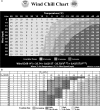National Athletic Trainers' Association position statement: environmental cold injuries
- PMID: 19030143
- PMCID: PMC2582557
- DOI: 10.4085/1062-6050-43.6.640
National Athletic Trainers' Association position statement: environmental cold injuries
Abstract
Objective: To present recommendations for the prevention, recognition, and treatment of environmental cold injuries.
Background: Individuals engaged in sport-related or work-related physical activity in cold, wet, or windy conditions are at risk for environmental cold injuries. An understanding of the physiology and pathophysiology, risk management, recognition, and immediate care of environmental cold injuries is an essential skill for certified athletic trainers and other health care providers working with individuals at risk.
Recommendations: These recommendations are intended to provide certified athletic trainers and others participating in athletic health care with the specific knowledge and problem-solving skills needed to address environmental cold injuries. Each recommendation has been graded (A, B, or C) according to the Strength of Recommendation Taxonomy criterion scale.
Keywords: chilblain; environmental physiology; frostbite; frostnip; hypothermia; immersion foot; pernio; trench foot.
Figures






References
-
- Sallis R, Chassay C.M. Recognizing and treating common cold-induced injury in outdoor sports. Med Sci Sports Exerc. 1999;31(10):1367–1373. - PubMed
-
- Rav-Acha M, Heled Y, Moran D.S. Cold injuries among Israeli soldiers operating and training in a semiarid zone: a 10-year review. Mil Med. 2004;169(9):702–706. - PubMed
-
- Reynolds K, Williams J, Miller C, Mathis A, Dettori J. Injuries and risk factors in an 18-day Marine winter mountain training exercise. Mil Med. 2000;165(12):905–910. - PubMed
-
- Jones B.H, Rock P.B, Smith L.S, et al. Medical complaints after a marathon run in cool weather. Physician Sportsmed. 1985;13(10):103–110. - PubMed
-
- Castellani J.W, Young A.J, Ducharme M.B, Giesbrecht G.G, Glickman E, Sallis R.E. American College of Sports Medicine position stand: prevention of cold injuries during exercise. Med Sci Sports Exerc. 2006;38(11):2012–2029. - PubMed
Publication types
MeSH terms
LinkOut - more resources
Full Text Sources
Medical

